allo Audio Revolution DAC – Warm Autumn Evening Code
allo Audio decided to make something special with their Revolution DAC, and this is going to cost about 260 USD for the basic variant, but you’ll need to pay about 320 USD if you want a remote control, and a Power Supply with it. Given its price point, it will be compared to Palab M1 Mini DAC/AMP (500 USD), Pro-Ject DAC BOX DS (430 USD), and iFi xDSD DAC/AMP (400 USD).
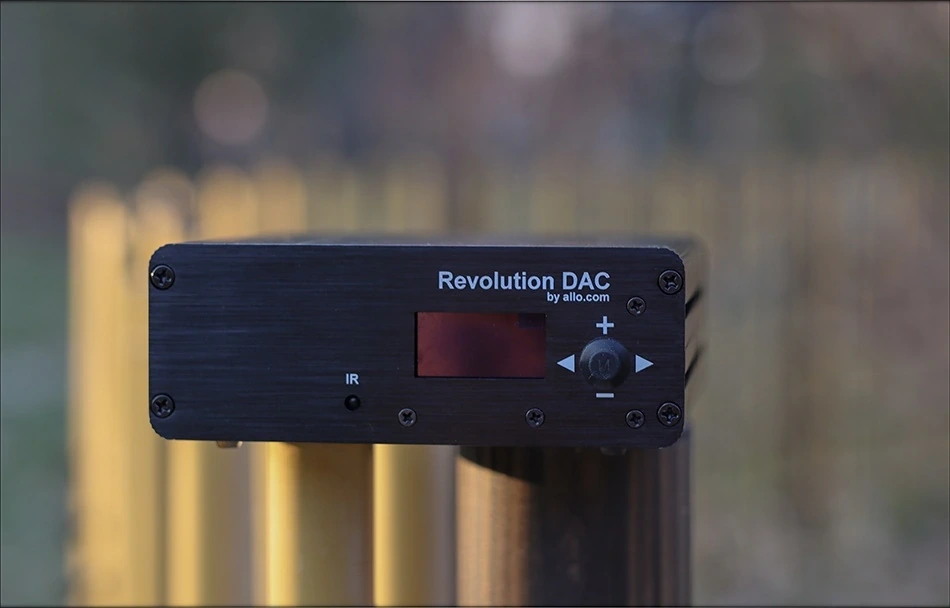
Introduction
ALLO Audio is really really reliable, they’re a company that takes great pride in both measurements and technical data, but also subjective reviews of their products, and they’re known for making cost-effective solutions, along with great designs. Most of the products on the official website are components for streamers and Raspberry Pi computers, but they have something for everyone. They are reliable, very open to conversation, and will help you figure out what’s the best product for you. The overall warranty provided by ALLO Audio is among the best out there, and you’re less likely to have one of their products break on you than you’re to win the lottery, at least judging by the fact that not a single person so far reported having had any issues with them.
It should be noted that I have absolutely no affiliation with ALLO. I’d like to thank ALLO for providing the sample for this review. This review reflects my personal experience with ALLO Revolution DAC, driven by Nirvana SMPS. Every opinion expressed is mine and I stand by it. The purpose of this review is to help those interested in ALLO Revolution DAC find their next music companion.
Product Link
You can grab one from www.amazon.com here: https://amzn.to/3pgE5ru
If you’re in the UK, you can grab one from www.amazon.co.uk here: https://amzn.to/3jgHGC7
And if you’re from Europe, you can grab one from www.amazon.de here: https://amzn.to/30Gpqfa
Packaging
First things first, let’s get the packaging out of the way:

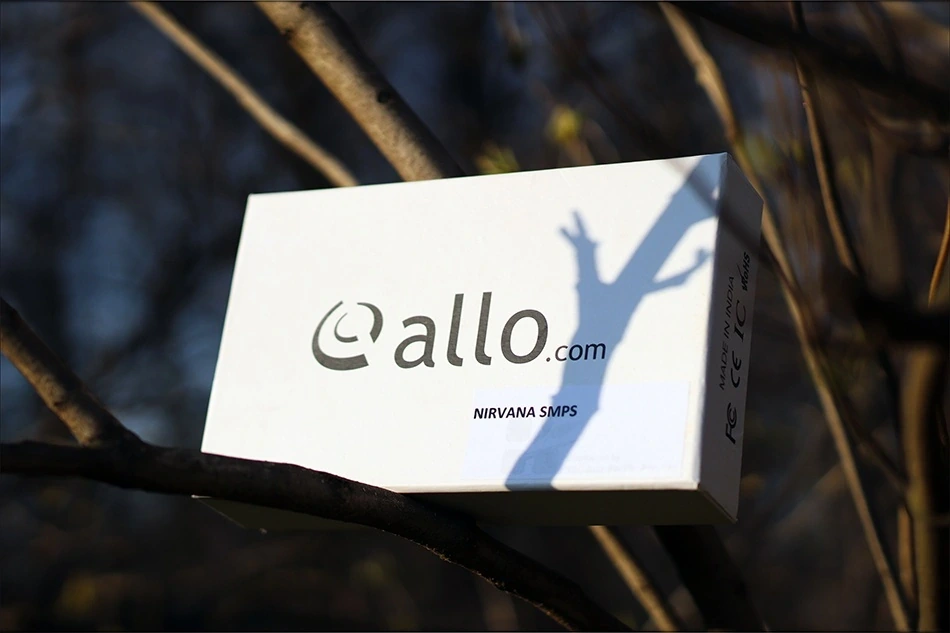
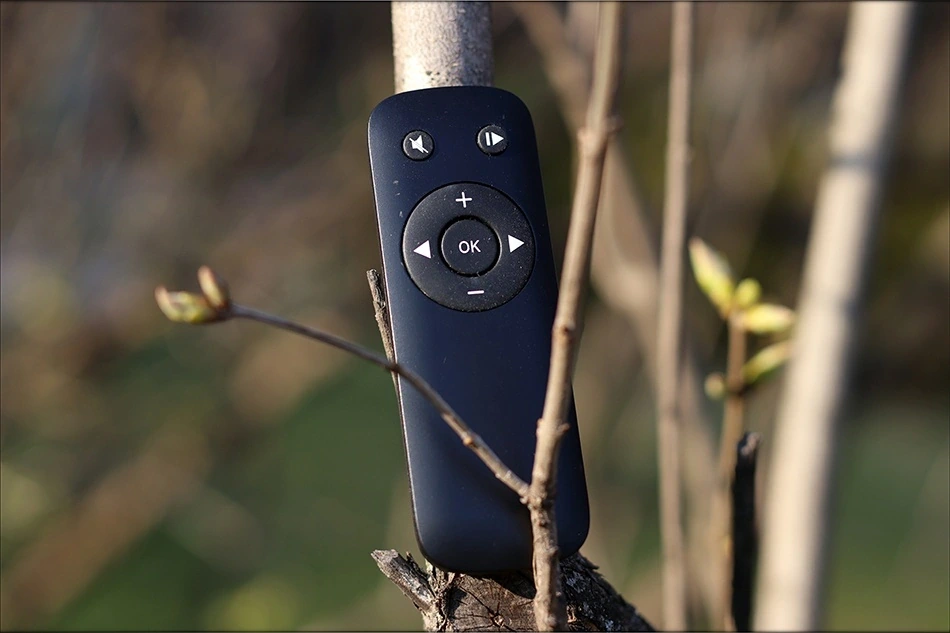
The package for the Revolution DAC is spartan, and so is the package for the Nirvana SMPS Power Supply. A SMPS is a switching Power Supply, and they also have a Shanti Linear Power Supply available, which will cost a bit more.
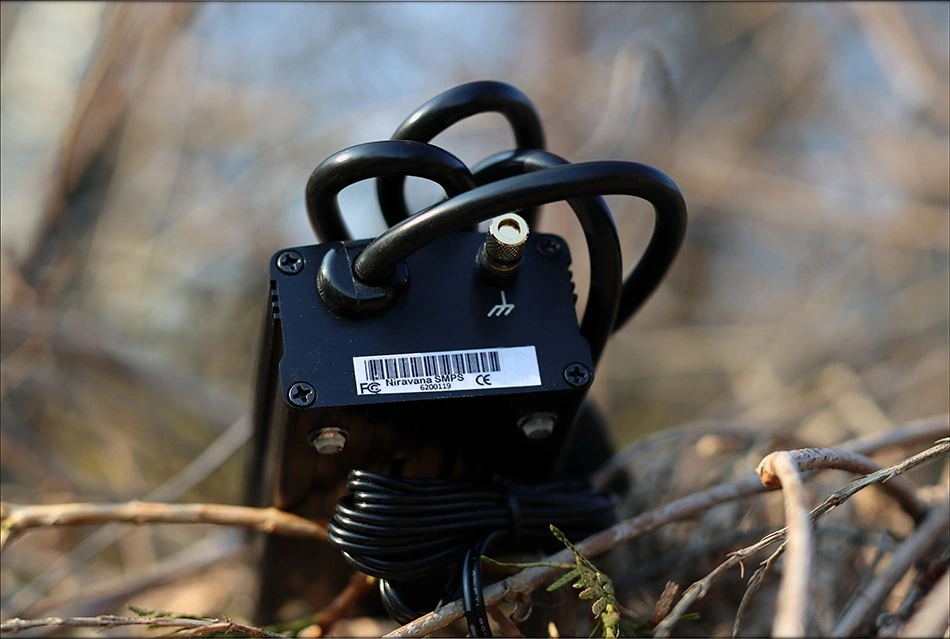
The package offers good protection to what’s inside, but ALLO is very much geared towards being practical and offering a good price / performance ratio, rather than being all fluff but less bite.
Build Quality/Aesthetics/Functionality
I want to start by recommending and urging you to purchase a Revolution DAC with a remote, because it is going to make usage so much easier. The DAC has a very diminutive display at the front, and next to it is a button / knob that you use to navigate the menus of the Revolution DAC. At the back we have the power input, which takes a 5V Power Supply, the microUSB Input, and the RCA outputs. That’s pretty much everything and there are no extras with the revolution DAC.
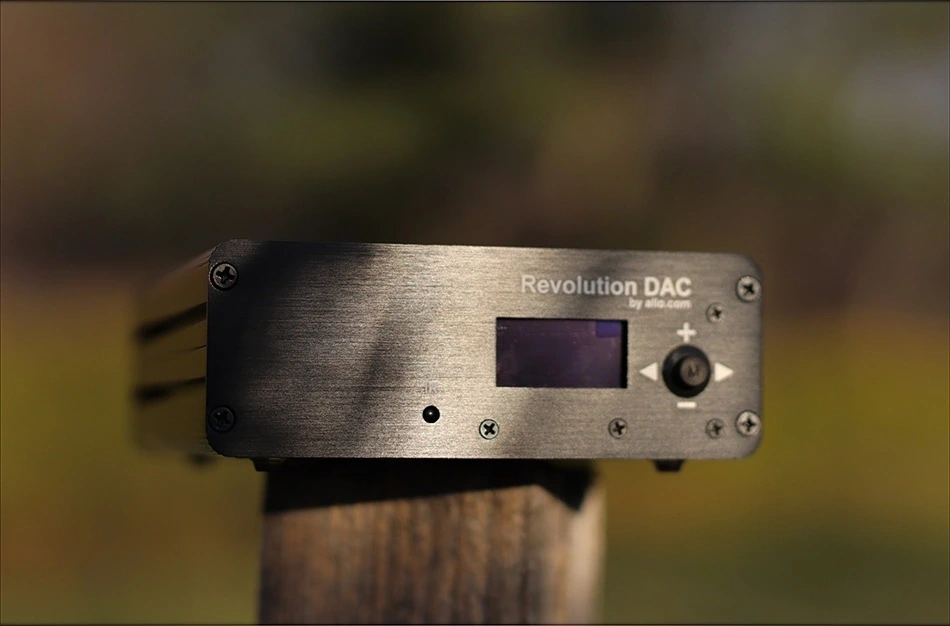
Despite it being a very pragmatic solution, the device looks pretty cool and doesn’t get warm during usage, being the kind of DAC that’s cool as a chiller. If you go to the support page of the Revolution DAC, you will find a thick page of specifications, actual measurements and interesting data. If you’re here just to listen to some music, most of the stuff there won’t make sense, and in actual honesty, it is above what most power users know and care about when it comes to a DAC in this price range. I like a company who cares about their products and takes the time educate their prospects. It helps in knowing what to expect from their products.
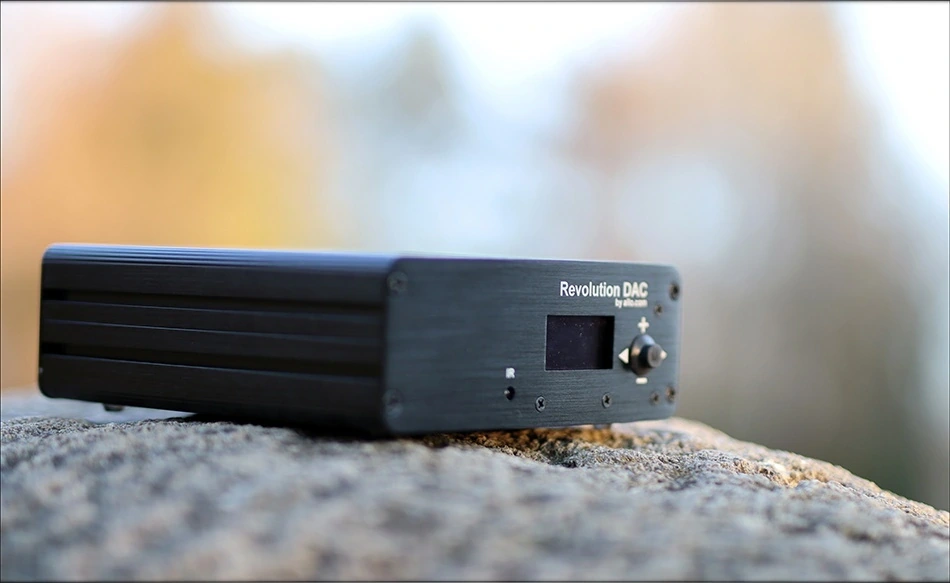
Besides using a USB input and powering some speakers, Revolution DAC has multiple filters, there is volume control, but you can bypass the OSF or oversampling filter and you can disable the volume control. There is an option named H3/H4 harmonic control, which is used for setting up the sound if you prefer more or less harmonics, so a more euphonic sound (more harmonics) or a more technical sound (less harmonics). There’s a Sync / Async option too, and we have a popmute, which basically mutes the sound a bit between songs and can eliminate pops if you get them, especially if you have different file rates / file types between files.
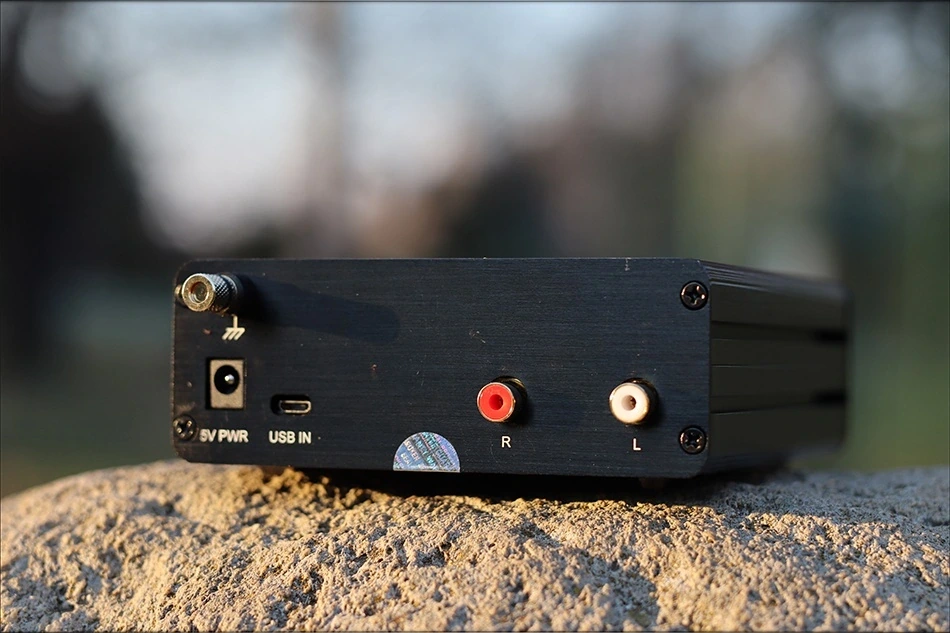
Interestingly, the company placed a hardware volume controller on the Revolution DAC, rather than a soft one, and this means that there should be no quality loss even if you use the volume control. That will help a lot if your amplifier doesn’t have volume control, or if without volume, Revolution DAC is sending louder music to your AMP than it expects and if you are experiencing clipping. Revolution DAC is pretty much my favorite kind of entry-level geek DAC, very technical and power-user friendly, and made in such a way that you learn more about audio tech while using it.
Sound Quality
For a company who puts in so much effort for the technical part of their design, allo audio surely doesn’t talk a lot about how the revolution DAC actually sounds. They mostly describe it as having very low THD or total harmonic distortion, so we can expect a really clear sound, and the company states that they believe the Revolution dAC does not have the brightness often associated with ESS DAC chips. I searched multiple websites, but I’ve been unable to confirm what exact DAC chip is used inside of the revolution DAC.
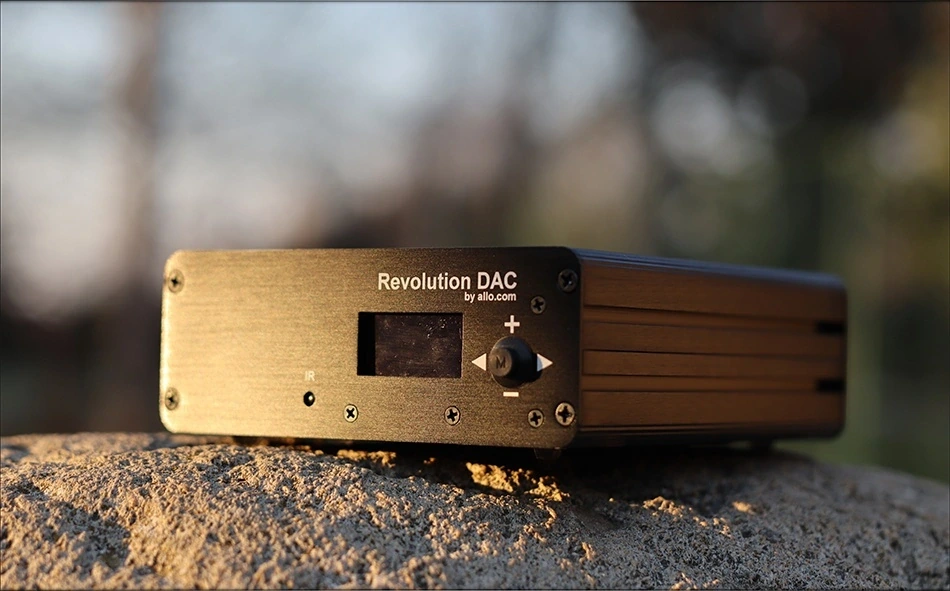
Now, with all of that out of the way, the sonic presentation of the Revolution DAC is exceptionally clean, clear, crisp, it is actually pretty fatigue free in the treble and doesn’t edge on that harsh and grainy ESS presentations we sometimes saw in old ESS implementations, and it is also pretty good with spatiality. The presentation is also fairly light and uncolored, neutral, and has good instrument separation and micro detailing.
The bass presentation of the revolution DAC is really clean, very quick, but with a neutral amount of bass. This means that it has very little coloration, it is very technically correct, but won’t warm up and have extra sub-lows or extra punch compared to warmer and more colored solutions. Depending on what you’re pairing the revolution dAC with, this can be a blessing, or can result in the whole system sounding a bit bright or too light.
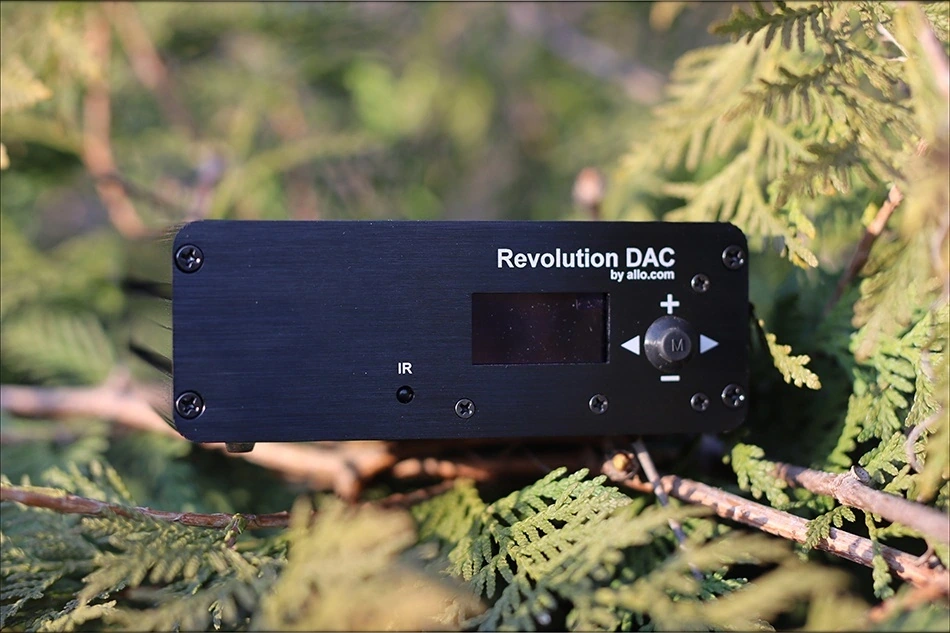
The midrange of the Revolution DAC is exceedingly clean, crisp and also uber-detailed. There’s a good sense of space, but the width is pretty equal to the depth of the soundstage. It has a good emotional presentation, and I’ve heard more micro-detail than I expected, and about as much detail as most 700 USD DACs are able to generate, but at the same time I heard zero grain and zero harshness from it. They really did manage to avoid that ESS edge by implementing a certain amount of passive filter between the DAC and the OP-AMPs.
The treble of the Revolution DAC is fairly perky and uplifted, and given the neutral amount of bass, it actually can sound bright per tonality, but doesn’t have that ESS brightness the company wanted to avoid. Basically, it has a good amount of treble, detail and sparkle, but it is smoother in texture, so you’re not going to have a headache at the end of the listening session. All in all the signature works well especially if you have a warmer setup for the rest of it.
Comparisons
Given the price, I tried to include comparisons with more expensive products, to put the value of the Revolution DAC to stress, at least a bit, so I went with iFi xDSD, Pro-Ject DAC BOX DS, and Palab M1 Mini. This should reveal whether it is a good idea to go for allo Revolution DAC. When I mention the Revolution DAC being bright, I mean that it has more treble in relation to its bass, not that it has a grainy or harsh sound, which is often associated with brightness and the ESS signature. This is important because its neutral sound will make it brighter, by comparison, than any entry-level and even mid range DAC, all of which are usually warmer and smoother, sometime gently rolled off to mask what would otherwise be unwanted brightness or uncontrolled treble.
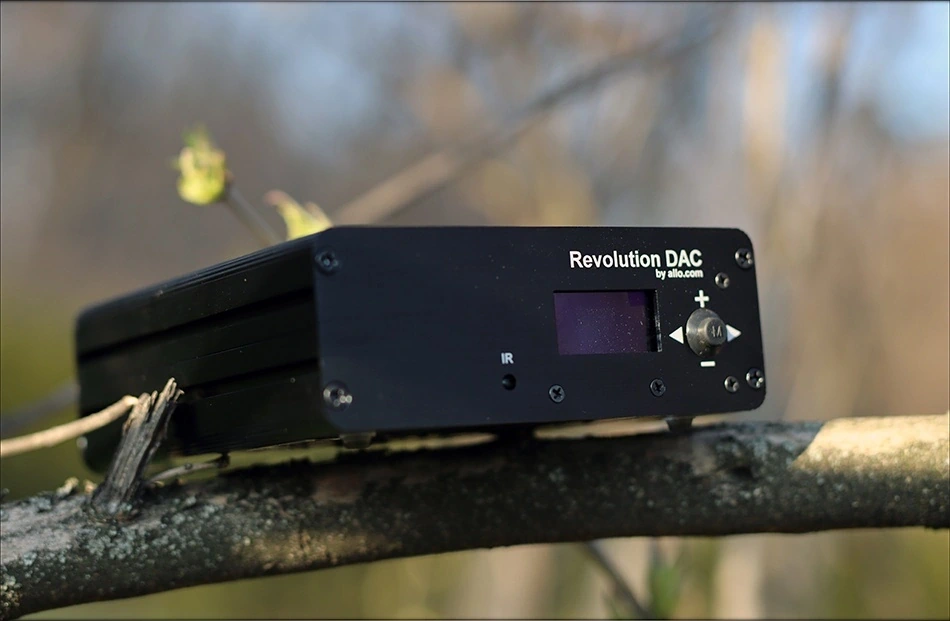
Allo Revolution DAC vs iFi xDSD DAC/AMP (320 USD vs 400 USD) – This comparison, like the one after it, won’t be totally fair, because both xDSD and M1 Mini can drive headphones too. Given the price, though, I wanted to note that xDSD has a different sound, it is much more colorful and vivid, while Revolution DAC is more neutral, has more detail, better resolution and overall clarity, but less bass, less impact. If your system needs a really clean, crisp and detailed source, the Revolution DAC should be perfect for you, while if you want something to sound more fun, with more bass, a wider soundstage, and more color in the sound, xDSD should be your choice.
Allo Revolution DAC vs PALAB M1 Mini DAC/AMP (320 USD vs 500 USD) – M1 Mini is like an upgraded Chord Mojo, it is portable, but it can also be used for desktop listening. It may not have RCA outputs, but it can be used the same as any DAC, and the low THD and great versatility means that I can actually recommend it as a desktop DAC. The main differences here are that the M1 Mini is much smoother, thicker, warmer, bassier and more fun tuned. Revolution DAC sounds more neutral, has a brighter presentation, and slightly more micro detail. I would generally recommend the M1 Mini more if you happen to have headphones or earphones too, and it has balanced output too, you can find a 4.4mm adapter and have a balanced DAC, while Revolution is single ended only. If you want a more neutral presentation, Revolution DAC would be a better choice, and it should make the best mini desktop DAC, especially as it has a remote that will come in handy.
Allo Revolution DAC vs Pro-Ject DAC BOX DS (320 USD vs 430 USD) – The comparison here is quite tricky, especially as DAC BOX DS is quite older than revolution. The general consensus is that Revolution DAC has more dynamics, more punch and is far more neutral, with a brighter presentation. DAC BOX DS is more limited in dynamics, it sounds more rolled off in the treble, with less energy, and less bass depth too. Generally, it is preferable to get the Revolution DAC at this date, especially at the new price of both, but DAC BOX DS is smoother and warmer, which can help a lot if your system and speakers are already plenty bright or neutral.
Value and Conclusion
We’re looking at an excellent value with allo Revolution DAC, it has a lot of life, good detail and has hardware volume control, all above a good construction. The Nirvana SMPS that’s included in the 320 USD price is also a good power supply, and you’re not likely to need iFi xPower or an upgrade. allo Audio also makes a power supply that’s linear, if you’re looking for more, and it won’t set you back much more, so allo Revolution is a really good value.
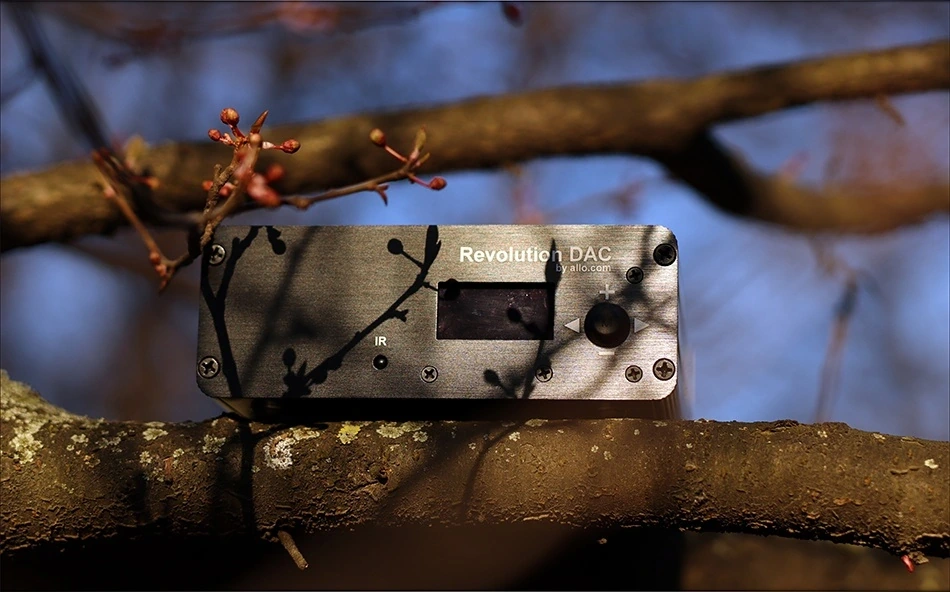
At the end of today’s review, if you’re looking for a really detailed, neutral sounding DAC with hardware volume control, good ergonomics, a small design, and remote control, the Revolution DAC from allo should be an excellent choice. In fact, it is so nice in value and overall sonics that I’m going to add the Revolution DAC to Audiophile-Heaven’s Hall Of Fame right before this review ends.
Product Link
You can grab one from www.amazon.com here: https://amzn.to/3pgE5ru
If you’re in the UK, you can grab one from www.amazon.co.uk here: https://amzn.to/3jgHGC7
And if you’re from Europe, you can grab one from www.amazon.de here: https://amzn.to/30Gpqfa
--- Please remember to stay safe, and always have fun while listening to music!---
- If you have a dime to spare, please donate, and help us! It would make the day brighter for me and my wife-
Full Playlist used for this review
We listened to more songs than those named in this playlist, but those are excellent for identifying a sonic signature. I recommend trying most of the songs from this playlist, especially if you’re searching for new music! The playlists are different for Spotify, Tidal and Youtube, and based on the songs I enjoy and are available on each!
https://www.youtube.com/playlist?list=PL_cjBXGmwSHSdGcwuc_bKbBDGHL4QvYBu
https://open.spotify.com/playlist/5J3oloz8Riy9LxEGenOjQ0?si=979ba4f082414be7
https://tidal.com/browse/playlist/330fd544-8e5b-4839-bd35-676b2edbb3d5
--- Contact Us ---






[…] I have used P14 to power multiple DAC/AMPs including Dethonray Listening M1, Keces Ebravo, Allo Audio Revolution DAC, Topping Audio A50 III. Every single time I noticed a similar improvement, but the biggest […]